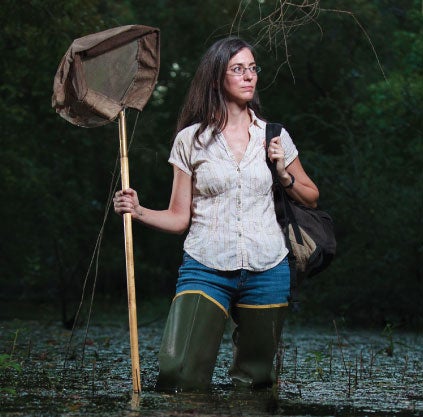 For generations of students, it’s been a gathering spot – a place to meet for lunch, to study or just soak up some sun. But for Allison Welch and her undergraduate research students, the small pond in the Stern Center Garden provides the perfect subject pool.
For generations of students, it’s been a gathering spot – a place to meet for lunch, to study or just soak up some sun. But for Allison Welch and her undergraduate research students, the small pond in the Stern Center Garden provides the perfect subject pool.
“There is a big population of Southern toads and tadpoles in there,” says the assistant professor of biology, who also collects eggs, tadpoles and toads from the College’s Dixie Plantation to use in her research on the effects of environmental changes on amphibians. “We use the Southern toad because they’re so common; we can take a few out of the environment without affecting the population. And amphibians in general make good models because their complex life cycle makes them vulnerable to changes in both the terrestrial and the aquatic environments.”
Plantation to use in her research on the effects of environmental changes on amphibians. “We use the Southern toad because they’re so common; we can take a few out of the environment without affecting the population. And amphibians in general make good models because their complex life cycle makes them vulnerable to changes in both the terrestrial and the aquatic environments.”
Welch’s interest in amphibian ecology has in recent years focused on conservation biology. For example, she is using tadpoles as a model for freshwater vertebrates to determine how the degradation of common drugs (i.e., ibuprofen and naproxen) affects them. These drugs pass through our bodies and – not completely removed by waste treatment centers – come out in our waterways.
“There has been a lot of research about pharmaceutical pollution in the past five years or so, but this takes it a step further,” says Welch, who is collaborating with associate professor of chemistry Wendy Cory for this project. “We really don’t know much at all about how the degradation of pharmaceuticals affects our environment.”
Welch and her undergraduate students are running acute tests, observing tadpoles exposed for four days to different levels of the original pharmaceutical or the compounds it breaks down into. Depending on the levels given, the molecules might kill the tadpoles, paralyze them or just make them lethargic.
“The prediction was that the degradation of the molecules is more harmful than the original compounds– and, so far, that prediction has been upheld,” says Welch.
In another project, Welch and her students are observing responses of tadpoles and toads to elevated salinity.
“Salt and amphibians don’t go together, and this could be a problem as freshwater habitats are becoming increasingly salinized,” says Welch. “We’re studying various life stages to try to understand how the salinity tolerance changes during their life.”
What they’ve found is that, once the toads become terrestrial, they can handle more salinity than they can at the aquatic stage of their life cycles.
“In the tadpoles, elevated salinity causes reduced growth and activity and, at 6 parts per thousand [ppt], death; but the toads like the 6 ppt as much as freshwater,” Welch explains, noting that seawater is around 35 ppt salinity. “So, this ability to tolerate salt in their environment changes. Maybe I was being naïve, but that surprised me.”
Of course, it’s just this characteristic of amphibians that make them so fascinating to scientists like Welch.
“The cool thing about amphibians is their metamorphosis. The two stages of their life cycle are so different,” says Welch, noting that tadpoles, for example, have mouths like little suckers, whereas the frogs they grow into have big, wide mouths. “Plus, they are just so cute!”
Yet another reason they make the perfect subject.
Photos by Kip Bulwinkle ’04




